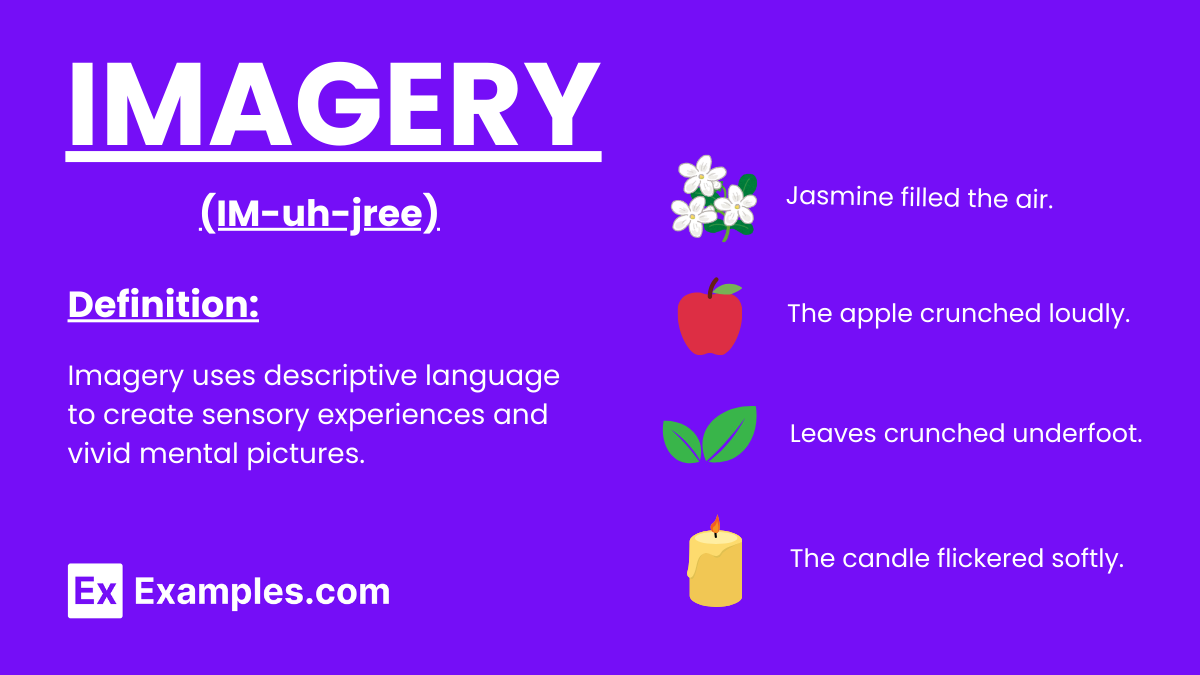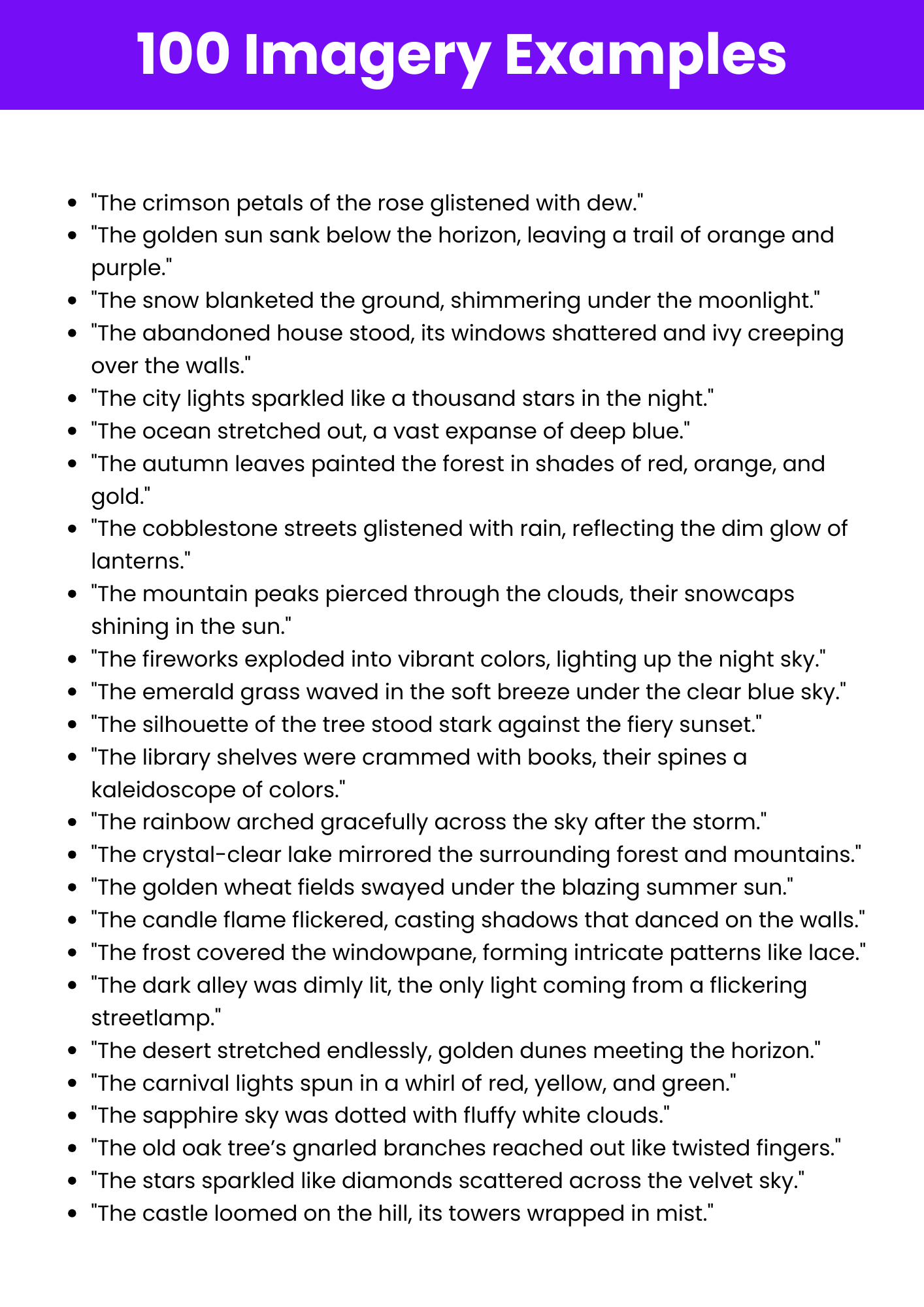Imagery
What is Imagery? – Definition
Imagery is a literary device that uses vivid and descriptive language to appeal to the senses, creating mental images that enhance the reader’s experience and bring scenes, objects, or emotions to life.

Generated Imagery Examples

Examples of Imagery
- “The golden rays of the sun warmed her face.”
- “The sky was painted in strokes of orange and pink.”
- “The garden was alive with the scent of blooming roses.”
- “The soup was thick, creamy, and filled the room with the aroma of garlic.”
- “The waves crashed against the rocks with a thunderous roar.”
- “Lightning split the sky, illuminating the night for a brief moment.”
- “The fire crackled, sending sparks dancing into the dark.”
- “Gray clouds loomed overhead, heavy with the promise of rain.”
- “The coffee was rich, bitter, and carried the warmth of morning.”
- “The forest was dense, alive with the rustle of leaves and the chirping of unseen creatures.”
- “The chalk squeaked against the board, leaving a trail of white dust.”
- “The projector whirred softly, casting flickering images onto the screen.”
- “The ball soared through the air, a blur of black and white.”
- “The car engine purred smoothly as it sped down the highway.”
- “The park was a burst of colors, from the green grass to the red tulips.”
- “The music swelled, filling the room with a melody of joy.”
- “The bulb flickered, casting long shadows on the wall.”
- “The laughter was warm, like sunlight breaking through a cold day.”
- “The athlete’s sneakers squeaked against the polished court floor.”
- “The wind whispered through the trees, carrying the scent of pine.”
- “The candle flickered, casting a soft, golden glow.”
- “The meadow buzzed with life, from the hum of bees to the rustle of grass.”
- “The city skyline glittered like a necklace of stars.”
- “The kitchen smelled of fresh bread, warm and inviting.”
- “The clock ticked relentlessly, each second echoing in the silent room.”
- “The crowd roared like a tidal wave, filling the stadium with energy.”
- “The artist’s brush moved gracefully, creating a world on the canvas.”
- “The stars winked down, tiny diamonds scattered across the night.”
- “The moon hung low, bathing the world in silver light.”
- “The wine was smooth, leaving a rich warmth lingering on the palate.”
Types of Imagery
Visual Imagery
Descriptive language that appeals to the sense of sight.
- “The sunset painted the sky in hues of orange and pink.”
- “The snow sparkled like diamonds in the sunlight.”
- “The forest was a patchwork of green and gold.”
- “The golden rays of the sun bathed the meadow.”
- “The stars twinkled against the deep velvet sky.”
Auditory Imagery
Language that appeals to the sense of hearing.
- “The thunder roared like a lion across the valley.”
- “The melody danced softly in the background.”
- “The waves crashed against the rocks in a rhythmic symphony.”
- “The crackling fire filled the silence with warmth.”
- “Birdsong filled the air as the forest came alive.”
Olfactory Imagery
Descriptive language that appeals to the sense of smell.
- “The scent of blooming jasmine wafted through the air.”
- “The aroma of freshly brewed coffee filled the room.”
- “The damp earth smelled rich after the rain.”
- “The kitchen was alive with the scent of baked bread.”
- “The pine forest carried the scent of crisp needles.”
Gustatory Imagery
Language that appeals to the sense of taste.
- “The tartness of the lemon made her lips pucker.”
- “The rich chocolate melted on her tongue.”
- “The savory stew warmed her from the inside.”
- “The crisp, salty chips crunched satisfyingly.”
- “The ice cream was sweet and creamy, with a hint of vanilla.”
Tactile Imagery
Language that appeals to the sense of touch.
- “The fabric was soft and smooth against her skin.”
- “The cold wind bit at her cheeks.”
- “The bedspread felt warm and comforting.”
- “The rough bark scratched against his hand.”
- “The rain drummed on her coat, soaking through.”
Kinesthetic Imagery
Descriptive language that evokes a sense of movement or physical tension.
- “Her legs burned as she sprinted up the hill.”
- “The dancer moved with a fluid grace across the stage.”
- “The rollercoaster soared and dipped, making her stomach flip.”
- “The oars sliced through the water with rhythmic precision.”
- “The hammer fell with a sharp motion, driving the nail deep.”
How to Identify and Understand Imagery?
Recognizing imagery involves analyzing descriptive language that appeals to the senses and enhances the reader’s experience.
- Look for words or phrases that create vivid sensory experiences.
- Identify descriptions that appeal to sight, sound, smell, taste, or touch.
- Notice how imagery helps set the tone or mood of the text.
- Analyze how the imagery enhances the theme or message of the work.
- Examine how imagery interacts with other literary devices, like metaphor or symbolism.
How to Use Imagery Effectively?
Using imagery effectively involves crafting descriptions that evoke strong sensory impressions and enrich the narrative.
- Choose precise and vivid language to paint a clear picture for the audience.
- Incorporate sensory details that align with the story’s mood or theme.
- Balance descriptive imagery with action to maintain pacing and engagement.
- Avoid overloading descriptions; focus on meaningful and impactful details.
- Use imagery strategically to evoke emotions and enhance the reader’s connection to the narrative.
Other Examples of Imagery
Emotional Imagery
Language that evokes feelings, moods, or emotional states.
- “Her heart felt as heavy as a stone after the bad news.”
- “Anxiety gripped him like a vice, refusing to let go.”
- “Joy bubbled inside her, effervescent and uncontrollable.”
- “Despair painted the room in shades of gray.”
- “A flicker of hope illuminated her thoughts.”
Symbolic Imagery
Imagery that uses symbols to represent abstract ideas or concepts.
- “The white dove soared above, a symbol of peace.”
- “The endless ocean mirrored the vastness of her dreams.”
- “The storm clouds rolled in, a harbinger of impending chaos.”
- “The withering tree stood as a symbol of forgotten times.”
- “The blooming flowers spoke of renewal and life.”
Temporal Imagery
Language that captures the passage or essence of time.
- “The setting sun bathed the horizon in gold.”
- “Moments slipped away like sand through fingers.”
- “The seasons turned, painting the earth in hues of change.”
- “The calendar’s empty pages marked the end of an era.”
- “The clock’s relentless ticking echoed in the silent room.”
Psychological Imagery
Language that evokes mental or introspective experiences.
- “The weight of unspoken words pressed heavily on her mind.”
- “Memories flashed like a montage in his head.”
- “Her thoughts unraveled like a thread pulled too tight.”
- “The calmness of her breathing steadied the storm within.”
- “A spark of realization lit up his mind.”
Spatial Imagery
Imagery that describes the arrangement or movement of objects in space.
- “The mountains loomed over the valley, casting long shadows.”
- “The narrow alley twisted and turned like a maze.”
- “The stars were scattered across the sky, forming constellations.”
- “The bridge stretched across the river like a silver thread.”
- “The city skyline pierced the horizon with jagged spires.”
Abstract Imagery
Imagery that conveys ideas, concepts, or qualities that cannot be perceived through the senses.
- “Freedom felt like the open sky, limitless and eternal.”
- “Hope shimmered faintly, a fragile glow in the darkness.”
- “Love wove an intricate tapestry, connecting hearts in unspoken ways.”
- “Time was a relentless tide, eroding everything in its path.”
- “Courage was the unseen force driving her forward.”
Explore Other Literary Devices
Elevate Your AP English Preparation
Unlock your potential with our comprehensive AP English exam preparation tools designed to help you excel.
- Extensive Question Bank: Access 900+ exam-like questions for both AP English Language and Literature.
- Expertly Crafted: Questions mirror the structure and difficulty of actual AP exams, ensuring relevant practice.
- Detailed Explanations: Understand your mistakes with clear, concise breakdowns of correct and incorrect answers.
- Personalized Learning: Tailor your study sessions with topic-specific tests and adaptive learning tools.
- Comprehensive Coverage: Master all aspects of the AP English curriculum with extensive guides and resources.
Frequently Asked Questions
-
What is imagery in literature?
Imagery refers to the use of descriptive language that appeals to the senses to create vivid mental pictures in the reader’s mind. -
Why is imagery important in storytelling?
Imagery is crucial because it enhances the reader’s experience by evoking emotions, creating atmosphere, and making scenes more engaging and relatable. -
What are the main types of imagery?
The main types of imagery include visual (sight), auditory (sound), olfactory (smell), gustatory (taste), tactile (touch), kinesthetic (movement), and abstract imagery. -
How does imagery affect the tone of a story?
Imagery influences tone by setting the mood and creating a specific emotional response, such as tension, serenity, or excitement. -
What are examples of visual imagery?
Examples include “The golden sun dipped below the horizon, painting the sky in hues of orange and purple” or “The frost sparkled like diamonds on the ground.” -
Can imagery be used in poetry?
Yes, imagery is a vital element in poetry, helping to evoke emotions and create vivid scenes through concise and impactful language. -
What is abstract imagery?
Abstract imagery conveys ideas or emotions that cannot be perceived through the senses, such as “Hope sparkled like a distant star.” -
How can writers improve their use of imagery?
Writers can improve imagery by using specific details, employing vivid metaphors and similes, and appealing to multiple senses in their descriptions. -
How does imagery differ from symbolism?
Imagery creates mental pictures using sensory details, while symbolism uses objects, characters, or events to represent deeper meanings. -
Can imagery enhance character development?
Yes, imagery can reveal a character’s emotions, thoughts, or background by describing their surroundings, actions, or interactions in detail.

